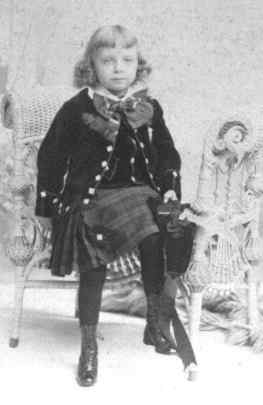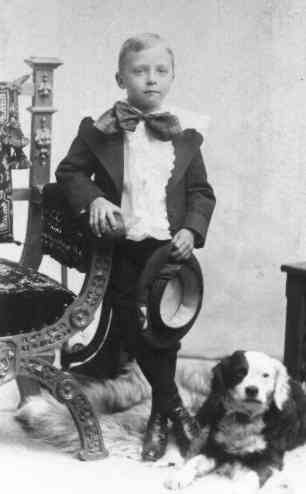
Figure 1.--This New York boy is dressed in a fancy kilt in this photograph taken in the 1890s. Notice the extremely long streamer on the cap he is holding in his left hand.

Figure 1.--This New York boy is dressed in a fancy kilt in this photograph taken in the 1890s. Notice the extremely long streamer on the cap he is holding in his left hand. |
Photographic records beginning about the 1850s begin to provide us information about the breeching of boys. Often no information is available on the boys pictured, but some information, however limited, can be gleaned from the photographic images.
I have little information on this boy. I do know he is an American. Based on the photographic studio he lived in Auburn, New York. Based on the elegant clothes I would say that he cam from a wealthy family. The photographs appear to have been taken in the 1890s.
This boy looks to be about 7 years old in his fancy kilt outfit. It is a Scottish kilt with a plaid tartan kilt and not the kilt suits worn by many boys with the styling of a proper Scottish kilt. His kilt out fit lacks some elements of a Scottish kilt, like the jabot lace collar, the sporran, and knee socks. He does have the military-like velvet jacket a ???? cap which he is holding in his left hand. The cap has an extremely long streamer. Unlike many boys his age he is not wearing a large lace collar with his kilt, but he does have a large bow.
Unlike some mothers, his mother had decided not to cut his hair before breeching. Although he does not have the more common shoulder-length ringlets, he does have long over-the-ears hair which almost reaches his shoulders. It looks like it might be naturally curly. It is possible that as a younger boy he wore ringlet curls. In figure 1 note the carefully "V" shaped center part. One major decision was whether to cut a boys' curls before, during, or after breeching. Mothers in the 19th Century had all kinds of ideas about this. Clearly this boys mother was not going to cut his hair until he was breeched.
One interesting question is what the boys at the time thought about the clothes mother chose for them. Boys were more complacent at the time and wore what mother purchased for them with little complaint. We know, however, from memoirs that they did have definite ideas of their own. Some boys for example objected more to their long hair than the clothes, others preferred kilts to Fauntleroy suits and visa versa. Unfortunately with this boy we have no idea what he thought.
Mothers in the 19th Century had many different ideas about breeching. It is impossible to tell for sure, but the photographs here suggest that he was probably breeched at about 8 years of age. It is possible of course that he was breeched earlier and that had a kilt outfit that he just wore occasionally. This would have been possible in Britain, but I think it is less likely in America.

Figure 2.--This New York boy is dressed in a fancy kilt in this photograph taken in the 1890s. |
Some mothers insisted on preserving the occasion of their son's breeching with a formal photograph, to preserve the momentous event. The kilt photograph may have been taken on the occasion of his breeching. The family, however, appears ti be quite well to do so it may have been just a periodic photograph.
The boy after he was breeched wears a smart, well tailored suit with an elaborate Little Lord Fauntleroy blouse. It has a large lace collar which extends over his shoulders and extensive lace work at the front. He wears his jacket open so as to best show off the lace work of his blouse. He holds a flat-topped sailor cap with white silk lining and what looks like a small white bow. With his lace collar he has a large colored bow, but I can not tell what color.
Along with his breeching he has been given a very short hair cut which now has a center part.
Navigate the Boys' Historical Clothing Web Site:
[Return to the Main breeching page
[Introduction]
[Chronology]
[Clothing styles]
[Biographies]
[Bibliographies]
[Activities]
[Countries]
[Contributions]
[Boys' Clothing Home]